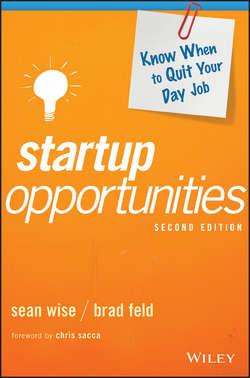Читать книгу Startup Opportunities - Sacca Chris - Страница 5
На сайте Литреса книга снята с продажи.
Preface
ОглавлениеEntrepreneurs dream of the magical moment in the creative process when they have a flash of clarity about how to solve a problem or make an innovative product. They often have an interesting story about this moment, and the origin stories of some successful companies have become legend. Yet, this moment of clarity often obscures the massive amount of work required to go from an idea to a real startup. From the outside looking in, a great company appeared out of nowhere. But the entrepreneur knows differently and remembers what had to happen to get from the idea to even the most embryonic startup.
As investors, we hear a simple question from entrepreneurs multiple times a day: “What do you think of my idea?” Sometimes the idea is well formed; often it is vague. Some have already been prototyped, others are just a few sentences in an email. Some have been thoroughly researched by an entrepreneur with deep domain knowledge, others are something completely new and different that the entrepreneur is exploring.
While it is easy to have an idea, it is incredibly hard to translate that idea into a successful business. The startup phase of a company requires a wide variety of activities to go from idea to successful startup. In the past few years, many books have been written about this process, including foundational ones such as The Lean Startup by Eric Ries, The Startup Owner’s Manual by Steve Blank, and Disciplined Entrepreneurship by Bill Aulet.
Nevertheless, we continue to hear some version of the same question over and over from aspiring entrepreneurs: “Is my idea any good?” Sometimes it’s phrased as “How do I know if my idea is good?” or “When I have an idea, how do I know if it’s good?” Often, this morphs into “I have the following three ideas. Which is the best one?”
Many of these entrepreneurs aren’t ready to stop what they are doing and dive all the way in to chase their new idea. Some have full-time jobs and are trying to figure out how this entrepreneurship thing works. Others are playing around with multiple ideas at the same time and trying to pick one or are stuck in the ideation phase, coming up with ideas and looking for external validation, but are unwilling to commit to working on a specific idea yet.
Ultimately, they are asking some form of the question “Will there be enough demand for this product that people will use it and pay for it?” Even after being pointed at books and approaches like the Lean Startup, they still have questions about whether their idea is any good.
It’s not a simple question to answer. Most successful companies go on a long and winding journey to find the answer. A founder used to write a comprehensive and tightly structured business plan that evaluated all aspects of the potential business. This document took hundreds of hours to write and tried to set up the theoretical case for the business without testing anything.
While business planning isn’t obsolete, the business plan is. It has been replaced by methodologies such as the Business Model Canvas, Business Model Generation, Lean Startup, Lean Launchpad, and Disciplined Entrepreneurship. Each of these methodologies uses a structured, experimental approach with quantitative feedback loops from potential users, customers, and partners to evolve an idea to a foundation upon which a startup can be built.
But that still leaves us with the questions “Is the idea any good?” and “Should I pursue this idea?”
It is possible to get to a better starting point if you spend some time in the opportunity evaluation phase. Before you even begin testing the idea and building on it, there are some fundamental questions you can answer. Through our work at Techstars, Dragons’ Den, and as early stage investors, we have found ourselves asking entrepreneurs the same set of questions repeatedly. While many of our conversations were short and detailed answers often weren’t forthcoming, we found that even the simple act of being asked the questions often helped the entrepreneur improve the idea.
It is not enough that you think your idea is a good idea. Others need to agree with you so that they will work with you either as partners, employees, investors, advisors, or customers. However, many entrepreneurs are afraid to share their idea with others for fear that it might be stolen. But as you’ll see in a moment, ideas need oxygen. In addition to engaging supporters and getting feedback, opening up ideas up and sharing them with trusted advisors as you are having the ideas can help evolve these ideas into something that you can build upon to create a startup.
Our goal with this book isn’t to replace existing methodologies. Instead, we want to complement them by giving you a context and a set of tools to help you evaluate your idea before you start putting any meaningful energy into it. Think of this exercise as the precursor to the Lean Startup or the Lean LaunchPad methodologies. We want this to be the book you read before diving into one of these methodologies, especially if you are a first-time entrepreneur.
The audience for this book isn’t just existing entrepreneurs or investors but a much larger class of readers – those who have yet to quit their jobs and take the leap into entrepreneurship. Hopefully, we will help you pick a better idea to build a startup around.
